Sommaire
Comprehensive Buying Guide – Vintage Moonphase Watches (Budget ≤ €2,000)
Did you know that some of the most complex watches in history can join your collection today for under €2,000? These post-war timepieces, often overlooked in the towering shadow of Submariners and Speedmasters, possess a unique magic: displaying the lunar star in a small window on your wrist.
Considering that an authentic Omega Cosmic, with its intricate movement and patinated dial, can be acquired for the price of an Apple Watch Ultra, one realizes the opportunity available to discerning enthusiasts.
I invite you to navigate with me through the intricacies of iconic calibers, lesser-known references, and authenticity tips that will make you a connoisseur of these small mechanical masterpieces. From the history of the first Felsa Bidynators to the subtleties of the Universal Genève Tri-Compax, embark with me on this exploration of miniaturized celestial time.
1. Historical Context
Full calendar watches with moonphase left an indelible mark on watchmaking in the 1940s and 1950s. At that time, integrating the complications of day, date, month, and moon phases into a wristwatch case was a technical feat, previously reserved for desk clocks or pocket watches. The appearance of these timepieces was a revolution for enthusiasts: they offered a miniaturization of time measurement in all its astronomical complexity right on the wrist.
Before the advent of moonphase watches, reading the lunar calendar on the wrist was uncommon. In the 1940s, houses like Omega, Universal Genève, Movado, Rolex, and Vulcain began designing “triple calendar” wristwatches with moonphase, capturing the post-war enthusiasm for technical and elegant objects. These models, often called “Datora” or “Full Calendar,” combined aesthetic refinement with mechanical prowess. Their appeal also lay in the watchmaking artistry required to synchronize the calendar mechanism with the lunar cycle (a calculation challenge of 29.5 days).
Historically, the invention of the first automatic caliber with bidirectional winding also propelled these watches to stardom. The Felsa Bidynator caliber, introduced in the 1940s, was the first to wind in both directions of rotation, a major advancement. Moonphase watches benefited from these innovations: by combining the lunar complication with reliable automatic movements, they became everyday companions, revolutionary in their combined autonomy and complexity. In short, the appearance of these watches was a small watchmaking revolution, democratizing the wearing of previously rare functions and symbolizing the art of “putting the Moon on your wrist.”

2. Major Movements & Complications
At the heart of every vintage moonphase watch lies a complex mechanical movement. The iconic calibers of the era combined engineering and ingenuity to power these complications. Here are the main ones:
- Felsa 693 “Bidynator” Caliber – A pioneering Swiss automatic movement from the 40s-50s. It belongs to Felsa’s second generation of Bidynators. The 693 is notably renowned as “the most complicated movement of this series,” featuring a complete triple calendar (day, date, month) and moonphase. Innovative, it offers efficient bidirectional winding. It equipped watches from brands like Record Watch Co or Favre-Leuba, often chronometer-certified. Special feature: it automatically switches from the 31st to the 1st of the month, avoiding tedious manual adjustment.
- Valjoux 90 Caliber – Swiss manual movement produced by Valjoux (a manufacturer famous for its chronographs). The Valjoux 90 is essentially a modified Valjoux 23/72 chronograph caliber without the chrono function but equipped with the full calendar. It reliably drives the day-date-month display and moonphase. Many triple calendar watches adopted it, including those from Universal Genève and more niche brands. Special feature: derived from a chronograph caliber, it is robust and precise, initially designed for reasonably sized cases (~34-36mm).
- Omega 27 DL PC / 381 Caliber – Omega developed its own movement for its “Cosmic” triple calendar watches. The 27 DL PC caliber (renamed Omega 381) is a manual movement with 17 jewels. Reliable and relatively thin, it displays the days and months via two windows below 12 o’clock, the date via a central blue hand, and the moon at 6 o’clock. It powered the Omega Cosmic from 1947 to 1956, the first Omegas with a complete calendar. Special feature: Its modest 27mm diameter allowed for the creation of elegant 34-35mm watches, and Omega even fitted it into highly sought-after 37.5mm “jumbo” versions.
- Universal Genève 481 Caliber – This movement powers the legendary Tri-Compax chronographs by Universal Genève (a combination of a “Compax” chrono with 3 counters + full calendar). It’s an integrated manual movement with 17 jewels, based on a modified Martel ebauche, including the chronograph function, triple calendar, and moonphase. Special feature: Its brilliant design accommodates 4 sub-dials (3 for the chrono, 1 for the moon) without cluttering the dial – a feat of legibility praised since 1944.
- Other notable calibers: Valjoux 88 (chronograph version of the 90, with an additional 12-hour chrono – used by Rolex, Doxa, etc.), JLC 494 (powers some Jaeger-LeCoultre triple dates), AS 1309/‘Moonphase’ by A. Schild, and Felsa 710 (an evolution of the 693). Each contributed, offering variations in size, power reserve, or layout, all while serving the same major complication.
The central technical challenge of these movements is coordinating multiple mechanisms:
- Full calendar: additional gear trains to advance the date daily, and jump the day and month at midnight when necessary (including managing month ends of 30/31 days).
- Moonphase: usually a lunar disc advanced one step approximately every 24 and a half hours (i.e., 59 teeth for ~29.5 days). The precision of this mechanism was already high for the time, achieving a deviation of only ~0.03 days per lunar cycle.
- Quick correction: most of these calibers feature discreet pushers on the case flank (usually at 2, 4, 8, or 10 o’clock) for quickly adjusting the day, date, month, and moon. For example, the Omega Cosmic has correctors at 2, 4, and 8 o’clock for the date, month, and moon.
This profusion of complications in such small volumes forced watchmakers to redouble their ingenuity. Movements like the Felsa 693 impressed contemporaries with their mastered complexity (featuring a full calendar and an automatic rotor, an absolute rarity). They testify to an era where watchmaking art reached new heights to display the course of civil and lunar time in a synchronized manner.
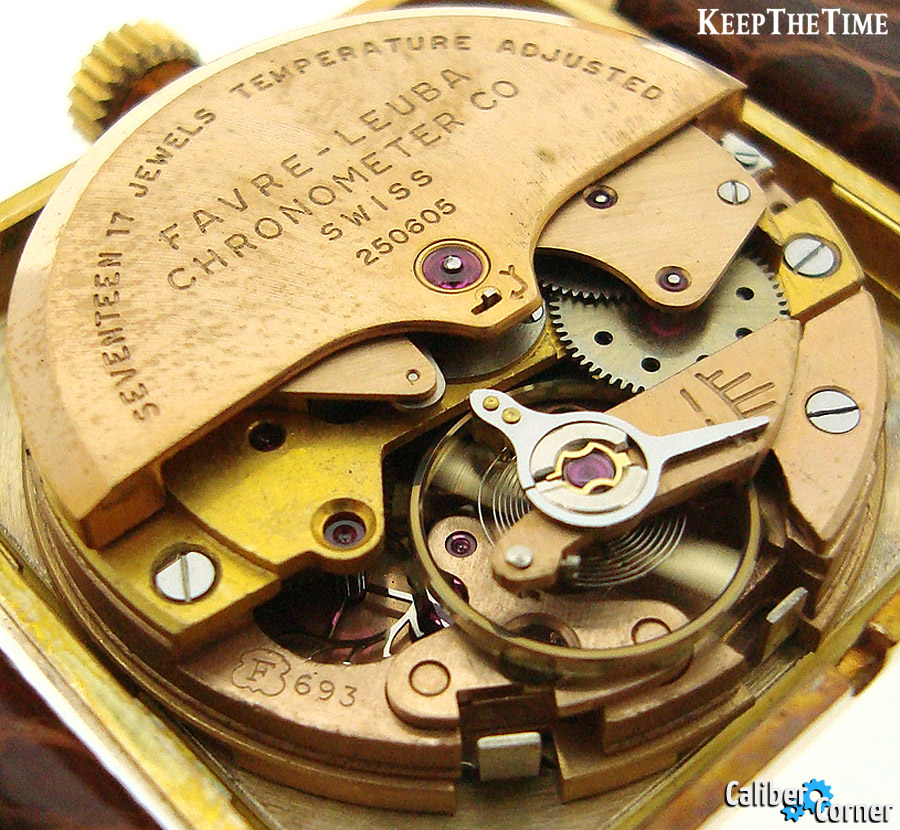
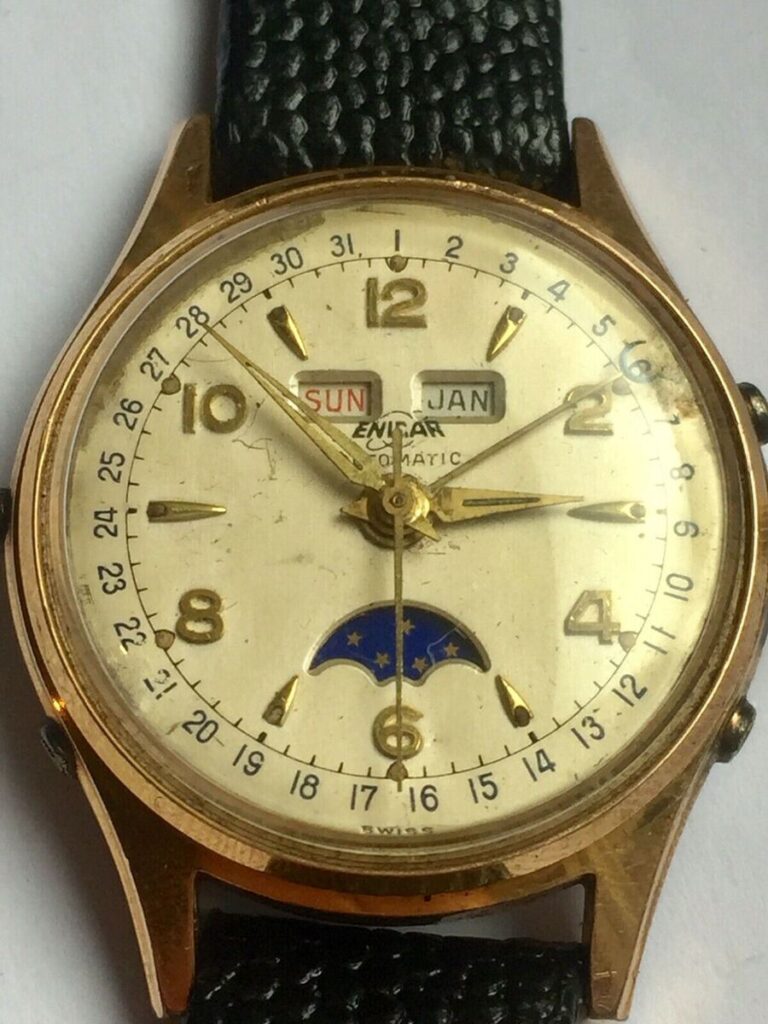
3. Essential References
Several vintage models stand out as “must-haves” in the affordable moonphase category. Here is a selection, each with its characteristics and technical specifications:
Omega Cosmic (1947-1956)
Description: The first Omega wristwatch with a full calendar. Classic round case, primarily produced in stainless steel, sometimes in 14K/18K gold. Domed dial with two windows below the Omega logo for the day and month, applied indices or painted Arabic numerals depending on the version, small seconds at 6 o’clock integrating the moon window. The “Cosmic” aesthetic is elegant and understated, very 1940s. It exists in two main sizes: ~34.5mm (standard) and ~37.5mm (known as “jumbo,” rare and highly prized). Typical references include 2471 (steel, 34mm, straight lugs), 2486 (steel, 37mm), and gold variations (ref 2472, 2473…). All share the Omega 381 caliber described above.
Discover the Omega Cosmic available on Catawiki (often rare pieces at auction).
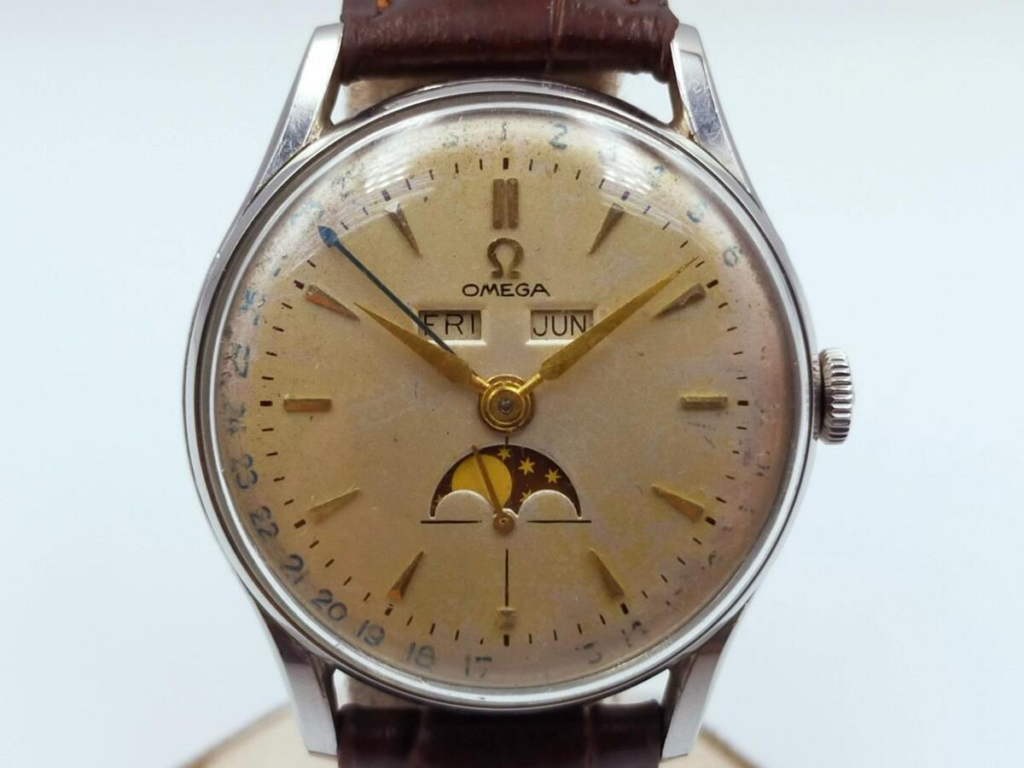
| Model | Omega Cosmic (Triple Date Moonphase) |
|---|---|
| Caliber | Omega 27 DL PC (cal. 381), manual 17 jewels, 2.5 Hz |
| Functions | Full calendar (day/month windows, date by central hand), moonphase at 6h, small seconds |
| Case | Stainless steel (majority) or yellow/rose gold 14-18K, snap-on case back |
| Diameter | ≈34 mm standard (ref. 2471…), exists in “jumbo” 37.5 mm (ref. 2486-1) |
| Dial | Silvered or champagne, gold indices or numerals, blue railway track for peripheral date |
| Production | 1947 – 1956 (Omega, Switzerland) |
| Current Price (2025) | Approximately €1,500 to €2,000 in steel depending on condition; gold or jumbo versions can exceed €2,500 |

Universal Genève Tri-Compax (1944-1960s)
Description: The Universal Genève Tri-Compax is a legendary chronograph incorporating a triple calendar with moonphase. Launched in 1944 to celebrate the brand’s 50th anniversary, its name “Tri-Compax” refers to the three major complications: chronograph, full calendar, moonphase. The dial is remarkable: 3 sub-counters aligned horizontally (30-min, 12-hour, small seconds) plus the moon window at 12h or 6h (depending on the series) associated with the peripheral date. The day and month windows are located at 11h and 1h. Several references exist across two main eras: the 1940s (e.g., ref. 22279 in 35mm steel, classic “binder” style) and the 1950s-60s (e.g., ref. 881101/01 known as “Eric Clapton” with a 36mm inverted panda black/white dial, or ref. 222100). Universal offered cases in rose gold, yellow gold, or steel, with diameters ranging from 34 to 37 mm. This model is generally more expensive, but some steel versions in average condition can be found around €2,000.
Find your Universal Genève Tri-Compax on Catawiki (opportunities not to be missed).
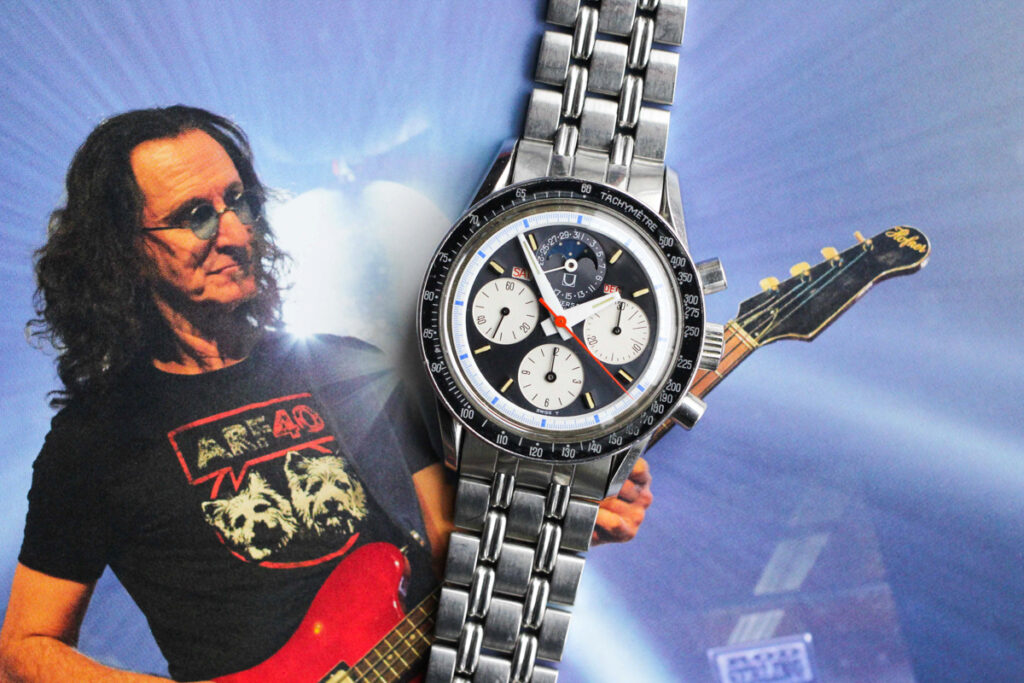
| Model | Universal Genève Tri-Compax (triple calendar chronograph) |
|---|---|
| Caliber | UG 481 (based on Martel cal. 90), manual, 17 jewels, 2.5 Hz |
| Functions | Chronograph (2 pushers, 12h – 30min – small sec), full calendar (day/month windows, date by hand), moonphase |
| Case | Stainless steel or 18K Gold (yellow/rose), screw-down or snap-on case back depending on ref. |
| Diameter | ≈34-36 mm (depending on ref., some late 60s “jumbo” 37mm) |
| Dial | Numerous variations: Arabic numeral or baton indices, bi-tonal versions (e.g., cream sub-dials on a black dial for the “Evil Clapton”) |
| Production | 1944 – approx. 1965 (Universal Genève, Switzerland) |
| Current Price (2025) | Variable (€3,000+ in good condition). However, incomplete or revision-needed steel Tri-Compax models can sometimes be found around €2,000 on the secondary market. |

Vulcain Cricket Calendar (1950s)
Description: Vulcain is famous for its “Cricket” alarm watch worn by US presidents. Less known is the Cricket Calendar model, which adds a full calendar with moonphase to the mechanical alarm. Produced in small quantities in the late 1950s, this piece packs complications: a central date hand; a day window at 3h; the month at 9h; the moonphase at 6h; and the alarm (often indicated by a specific hand or indicator). The ~35mm steel case houses a Vulcain movement with a double barrel (one for time, one for the alarm) coupled with a calendar module. Rare on the market, it’s a highly technical timepiece for its era.
The Vulcain Cricket Calendar is sometimes offered on Catawiki (explore current auctions).
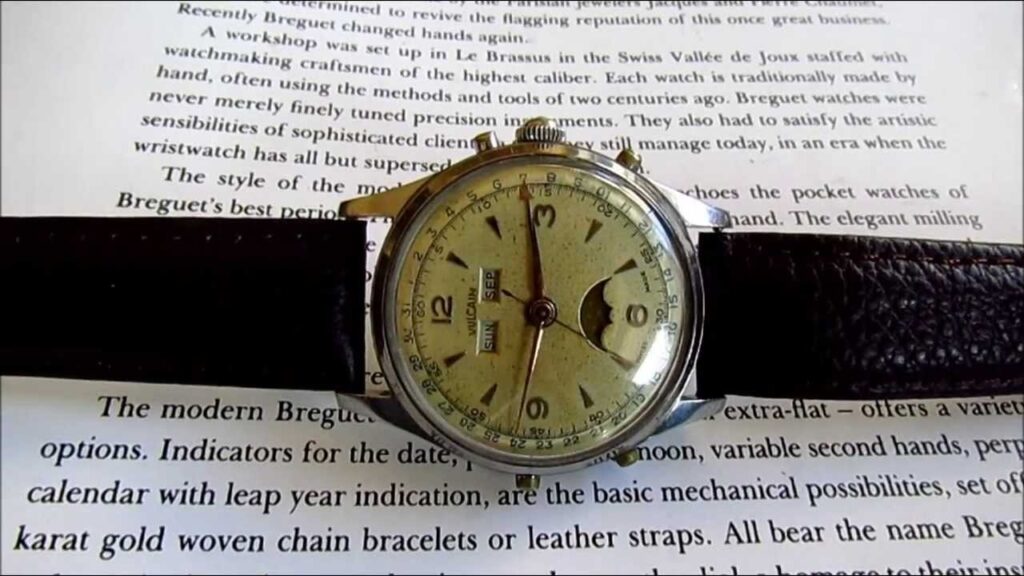
| Model | Vulcain Cricket Calendar (alarm + full calendar) |
|---|---|
| Caliber | Modified Vulcain Cricket Cal. 120, manual, 17 jewels (base alarm caliber + full calendar module) |
| Functions | Time, Mechanical Alarm (cricket), Date by central hand, Day/Month windows, Moonphase |
| Case | Stainless steel (a few rare gold-plated), screw-down case back for alarm resonance |
| Diameter | ≈34-35 mm |
| Dial | Often silvered, applied indices, two windows (3h and 9h) and a moon aperture at 6h above the alarm/seconds sub-dial. |
| Production | ~1953 – 1960 (Vulcain, Switzerland) |
| Current Price (2025) | Difficult to estimate (rare). Can be found between €1,800 and €2,500 depending on condition, sometimes more given the value of vintage Vulcains. |
Other Notable Models
- Jaeger-LeCoultre Futurematic Triple Date – JLC offered some calendar watches in the 50s (without moonphase, however) and Memovox calendars. Budget often >€2k.
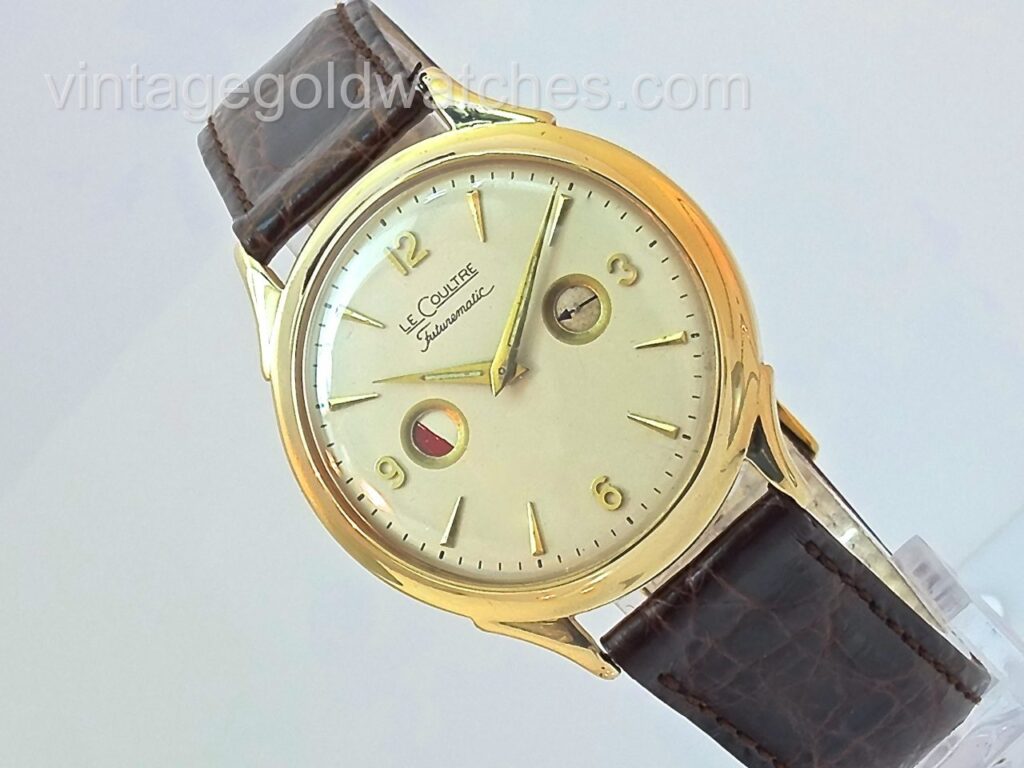
- Movado Calendograph – Charming triple date from the 40s, sometimes found under €1,500 in steel. No moonphase on most models, however (Movado reserved the moon for its very high-end pieces).
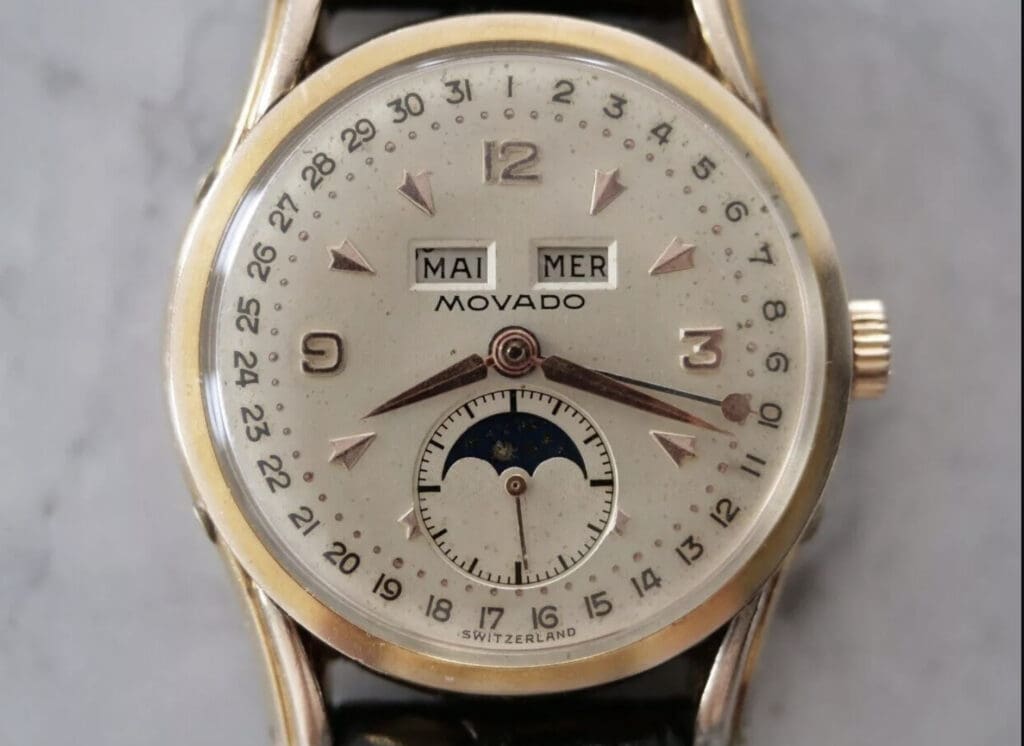
- Girard-Perregaux ww.tc Moon – Some post-war GPs incorporate a triple calendar moonphase, sharing calibers with other brands via A. Schild or Valjoux ebauches.
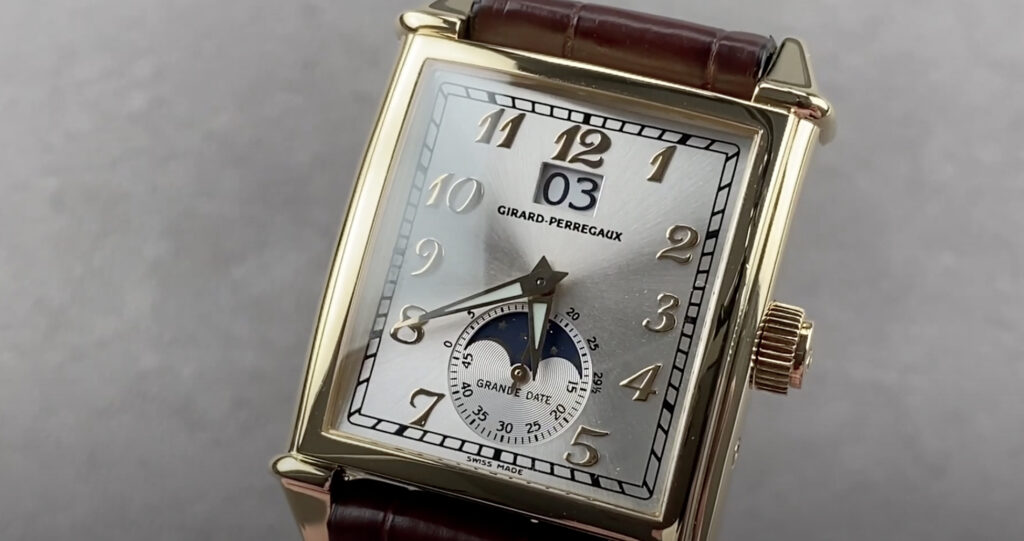
- “Forgotten” Brands – Many brands now defunct (e.g., *Nivada, Doxa, Enicar, Record, Helvetia…*) produced moonphase watches using the described calibers. Sometimes sold without the “prestigious brand” premium, they represent excellent value for money to build an affordable collection.
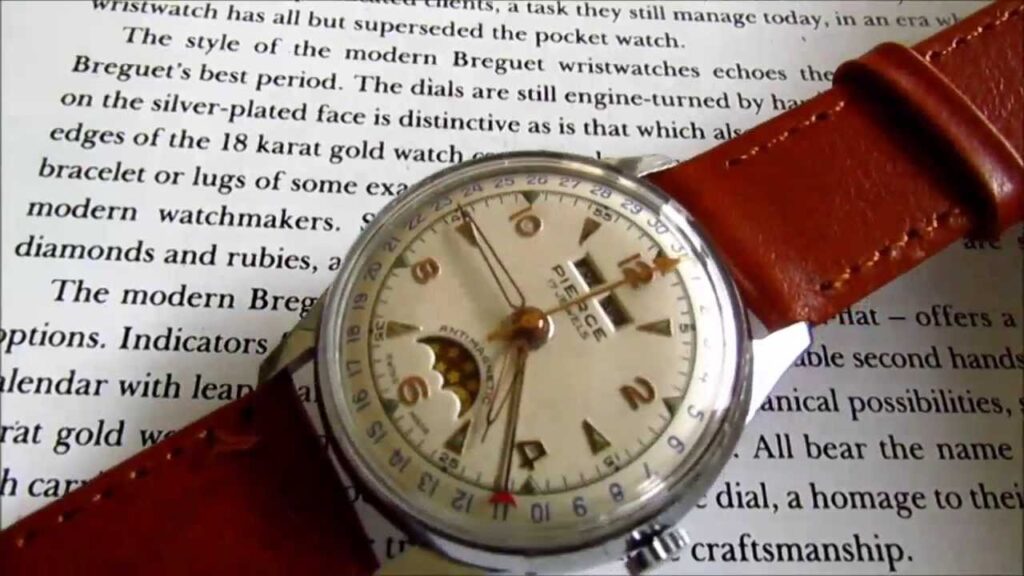
4. Price Evolution (Market 2022–2025)
The vintage watch market saw notable fluctuations between 2022 and 2025, and affordable moonphases are no exception. Here’s a summary analysis of trends, expressed in euros (€) and, for reference, in dollars ($) for the international market:
Year 2022: Renewed interest in vintage watches during the pandemic (2020-21) led to a price increase, still visible in early 2022. Steel Omega Cosmics traded around €1,200 (approx. $1,300-1,400) for a nice, complete, and functional example. Universal Tri-Compax models in decent condition often exceeded €2,500 (around $2,800), driven by the general craze for vintage chronographs. Models from lesser-known brands (e.g., a *Record* with a Felsa 693 caliber) could still be found under €1,000, delighting savvy collectors.
Year 2023: The year was marked by stabilization and a slight correction in the vintage market. Highly-rated watches saw their prices soften. Thus, the steel Omega Cosmic remained in the €1,100 – €1,300 range (stable average price with some notable auctions for “NOS” examples exceeding €1,500). In dollars, this corresponded to ~$1,200–1,400. The Universal Tri-Compax, some references of which hit stratospheric prices in 2021, saw a slight downturn: a somewhat patinated steel example could be traded around €2,200 (~$2,400). Vulcain Cricket Calendars, very rare on the market, benefited from Vulcain’s increased visibility (brand comeback, modern re-editions) – a fine example reached ~€2,000 on Catawiki in late 2023.
Year 2024: Fueled by a rising dollar and inflation, prices in euros climbed significantly on the international market. American collectors acquired numerous European pieces. Result: the standard Omega Cosmic in good condition often flirted with the €1,500 mark (approx. $1,600) by late 2024. Gold versions also rose (up to €2,500-3,000 depending on condition). For Universal, any unrestored and complete steel version easily sold above €2,500, with certain references (“Exotic dial” or “Eric Clapton”) even exceeding $4k (but this is outside the ≤€2,000 category). We also note the rise of “niche” pieces: triple dates from less prestigious brands are starting to appreciate, for example, an Enicar Star Jewels Moon Phase sold for ~€1,200 in Germany mid-2024, whereas it would have been estimated at €800 two years earlier.
Year 2025 (Current Trend): The market shows signs of slowing down for the most common models, which favors buyers. A slight decrease is observed for Omega Cosmics – good examples are now around €1,400 (±$1,500), sometimes slightly less via private sales. Tri-Compax models remain sought after, but a slight correction has occurred: a mid-range steel Tri-Compax trades around €2,300 (compared to €2,500-2,600 a year earlier). As for Vulcains and other rarities, their value heavily depends on condition and the presence of original components (unretouched dial, etc.). Overall, 2025 seems to offer an interesting buying window for these watches: speculative hype has calmed down, and prices are stabilizing at a reasonable level for such charming and complex collector’s items.
In summary, between 2022 and 2025, the price of triple calendar-moonphase watches ≤€2k saw an increase until 2024 followed by stabilization/slight decrease in 2025. In the long term, the trend remains upward (these pieces become rarer in good condition), but without excess: they remain “accessible” compared to other vintage segments. A budget of €2,000 in 2025 thus allows acquiring a steel Omega Cosmic in excellent condition, or possibly a Universal Genève in average condition, which was not a given a few years ago.
5. Buying Tips
Acquiring a vintage moonphase watch requires both passion and caution. Here’s an authentication checklist and tips to avoid pitfalls, along with recommended places to find that rare gem.
Authentication Checklist
- Original Dial: Check that the dial hasn’t been repainted (redial). A period dial often shows slight patina, clear inscriptions (logo, blue date scale, etc.) but sometimes slightly faded. Beware of dials that look too “new” on a 70-year-old watch. On an Omega Cosmic, for example, the thin “Swiss Made” mention at the bottom should be present and consistent. On a Tri-Compax, the “Universal Genève” and “Tri-Compax” writings should not appear blurry or thick.
- Movement & Numbers: Open the case (preferably by a watchmaker) to inspect the caliber and markings. The caliber must match the model: e.g., an Omega Cosmic should have an Omega cal. 381 with its serial number (range 10 to 12 million for the late 40s). Universal often placed the caliber number under the chronograph bridge (cal. 481). Also, compare the case/reference number with archives or databases (Omega often has the reference inside the case back). Discrepancies could reveal a “frankenwatch” (a watch assembled from disparate parts).
- Full Functionality: Test every complication: the date change at midnight (should jump correctly from 30 to 1 or 31 to 1 depending on the month), the progression of the day and month, as well as the moonphase. Use the correctors: they should operate without force. A stuck moonphase or a day that doesn’t change can indicate a worn or incomplete mechanism. This doesn’t necessarily mean you should run away (spare parts sometimes exist), but it’s leverage for negotiation or planning a service.
- Condition of the Moon and Disc: Inspect the moon itself. Often made of cardboard or painted brass, the period lunar disc might have paint chips or a slightly aged moon drawing. This is normal. However, a moonphase with overly bright colors or coarse stars can be a sign of a non-compliant replacement part. Better an original patinated disc than a flashy reproduction.
- Case and Dimensions: Ensure the case hasn’t been excessively polished (edges still defined, lug shapes respected). Verify the advertised diameter: some watches are sold as “jumbo” when they are 34mm, a confusion that can disappoint upon receipt. A reputable seller will provide the exact diameter excluding the crown. Compare against known references (a Tri-Compax 22279 is 35mm, for example, not 38).
Pitfalls to Avoid
- Incomplete Watches: A common pitfall is a watch whose complication is no longer complete. For example, it might be missing the moon disc or an adjustment pusher. Auctions have featured Omega Cosmics without the calendar module (just telling time) – likely stripped for parts – the watch permanently reads “January 1st” and has no moon… Avoid these wrecks unless you have a stock of spare parts. Specific components (moon disc, calendar wheel) are hard to find alone.
- Poorly Done Redials: As mentioned, a repainted dial significantly reduces collector value. Sometimes, the seller isn’t transparent about this. Learn to spot the signs (non-compliant logo font, absence of the fine minute track, missing or anachronistically present tritium). On calendars, a redial can also be spotted if the day/month windows seem too wide or poorly centered relative to the inscriptions – a sign the dial was stripped and poorly reconstructed.
- Fakes and Hybrids: Good news, pure counterfeits of these models are extremely rare (not profitable given the complexity). The risk is more the “Frankenwatch”: e.g., a case from brand X with a movement from brand Y. Or an assembly of a Valjoux 90 movement in an unbranded case sold as a Universal. Research the references: each model has specific traits (number of jewels, lug shape, etc.). Specialized forums can help you validate a watch via photos before purchase.
- Maintenance Cost: Not strictly a pitfall, but many underestimate the cost of servicing. Servicing a triple calendar is trickier (and thus more expensive) than a simple three-hander. Expect to pay €300 to €500 at a qualified watchmaker for a full service of a Valjoux 90 or Omega cal. 381, including complication adjustment. Factor this into your budget. A very low purchase price often hides a watch that hasn’t been maintained for ages.
Where to Buy? Best Addresses & Platforms
Here are some reliable buying channels for these vintage timepieces, in Europe and internationally:
- Specialized Auction Sites: Catawiki – The Dutch platform offers weekly sales of vintage watches, often curated by experts. Omega Cosmics or UG Tri-Compaxes regularly appear. Advantage: detailed photos, the ability to ask questions, and a transparent bidding system. Drawback: the buyer’s premium (9%) to consider. Also, Bonhams and Christie’s hold watch auctions where these models appear (sometimes in affordable lots), but it’s rarer and often involves gold Tri-Compaxes.
- European Vintage Dealers: Several online or physical shops are recognized for the quality of their pieces:
- Classic Caliber (Germany) – Specializes in vintage watches, often full calendars. For instance, they have previously offered “jumbo” Omega Cosmics. Market prices, serviced, with warranty.
- Mikael Dan (Paris) – Jeweler-watchmaker offering high-end vintage. Currently, for example, an 18K gold Omega Cosmic from around 1950 at ~€3k. Above the €2k budget, but instructive to see a beautifully restored example.
- Vintage Portfolio (Italy/USA) – Online site that has sold various Cosmics (their photos circulate on Pinterest). Worth watching.
- Time Rediscovered (UK) – English specialist, sometimes offering serviced UG Tri-Compaxes around £3k. You can entrust them with searching for a specific reference.
- Forums and Communities: Watch forums are valuable allies. On ForumàMontres (French-speaking community) or Omega Forums (English-speaking), classifieds between members allow for trustworthy purchases of watches whose history is often known. For example, a passionate member might sell a Universal Tri-Compax they’ve worn themselves for 10 years. The “passion” atmosphere often outweighs pure commercial transaction.
- International Marketplaces: Chrono24 remains a benchmark for filtering by model and viewing available offers. Currently (2025), you can find about half a dozen Omega Cosmics between €1,300 and €1,800. Be sure to check the seller’s reputation (prefer “Trusted” sellers or those with many positive reviews). Another platform to consider: eBay. You’ll find everything – the wonderful and the questionable. Advantage: eBay’s Buyer Protection tool and the possibility of finding good deals at auction. Ex: an incomplete Omega Cosmic 2471/1 sold for $1,130. Be prepared to use the return policy if the watch doesn’t match the description.
In conclusion, buying a vintage moonphase watch can be an extraordinarily rewarding adventure for the watch enthusiast – provided you prepare seriously. By following authentication tips, avoiding common pitfalls, and dealing with the right people, you can add a true piece of watchmaking history to your wrist. These watches, revolutionary in their time, are just waiting to live a second youth on your wrist, faithfully telling you not only the time, but also what day it is and… under which phase of the Moon we live!
- 开启您收藏之路的5款500欧元以下顶级古董表 - 30/04/2025
- Топ-5 вінтажних годинників до 500 євро для початку вашої колекції - 30/04/2025
- Топ-5 винтажных часов до 500 евро для начала вашей коллекции - 30/04/2025
